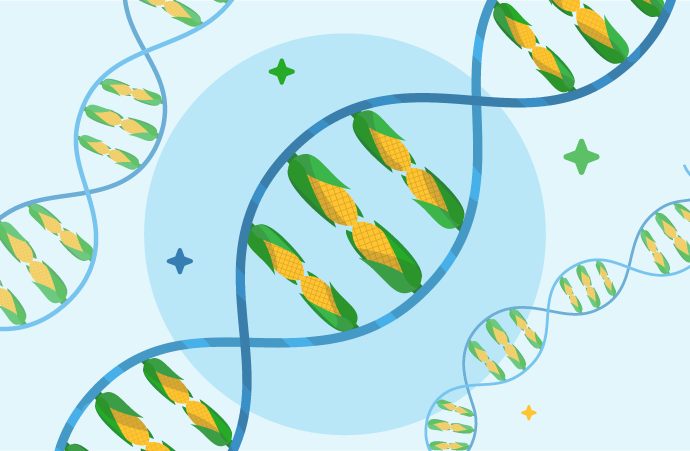In the mid-20th century, a little-known American agronomist named Norman Borlaug started experimenting with the genetic composition of wheat. After a decade of careful crossbreeding and engineering, he pioneered a cultivar that literally changed the world.
Borlaug’s famous ‘dwarf wheat’ – abundant, disease-resistant crops, able to withstand the weight of higher yields – is estimated to have saved one billion people from starvation and death. In 1970, it earned him a Nobel Peace Prize.
So, what does this have to do with agricultural biotechnology in 2024? Well, it’s worth remembering a few things. Not just that genetic engineering in agriculture has been around for a long time, but also the scale of the stakes involved. With the climate changing, population booming, and the future uncertain, biotechnology in agriculture will likely be the difference between a world that can feed itself, and a world that can’t.
How biotech in agriculture is reimagining food production
For a long time, genetic modification (GM) has been the cutting edge of agricultural innovation. It’s how we can eat what we eat for the price that we eat it. There are several areas of agricultural biotechnology that scientists are currently exploring, but one of the biggest advancements over the last few years has been the advent of CRISPR-Cas9.
CRISPR (which stands for – brace yourself – Clustered Regularly Interspaced Short Palindromic Repeats) is a gene-editing technology that allows scientists to modify an organism’s DNA with laser-like precision. Along with treating things like genetic disorders in humans, this means researchers can now grow crops with particular properties more reliably, and more accurately.
A closer look at agricultural genetic engineering techniques
So how does genetic modification actually work? Without getting too technical, to make a GM plant, you simply transfer new DNA into plant cells. These cells are then grown in a tissue culture where they develop into full-grown plants. The seeds produced by these plants hold the new DNA key, allowing propagation and widespread farming of specific cultivars and varieties.
Zooming in slightly, scientists add specific stretches of DNA into the plant’s original genome, altering its genetic instruction manual. This can be useful in all sorts of ways. Scientists can program plants to grow faster or produce sweeter fruit. They can engineer plants to be more resistant to disease, or even climate change. Food yields can improve dramatically. The potential is almost endless.
Agricultural biotechnology for a changing climate
In September 2023, we officially “blew past” 1.5 degrees of global warming above the pre-industrial average. This is the level, determined by the Paris Agreement, beyond which the entire planetary system could be thrown out of whack: economies, ecosystems, agriculture all at risk.
With this in mind, agricultural biotechnology could play a crucial role in Earth’s future; it’s one of the few things that can enhance the resilience, sustainability and productivity of agricultural systems.
We’re already seeing this in action. Researchers are quickly trying to grow climate-resistant crops that are more resilient to extreme temperatures. We’re also looking at crops that require fewer chemical inputs, such as pesticides and fertilizers. This not only reduces the environmental impact of those crops but helps mitigate against climate change by lowering greenhouse gas emissions. Other GM crops are being grown as carbon sequestration: literally sucking carbon out of the atmosphere and locking it in the soil with enhanced root systems.
Biotechnology in farming
By 2049, the global population is tipped to hit nine billion. This is obviously a huge challenge for farming and agriculture: how the heck are we meant to feed nine billion people? Especially considering that the yields for many major crops, like rice, corn and wheat, are stagnating?
This is where agricultural biotechnology really comes into play. It’s a technology that has a direct bearing on human welfare and food security. Just look at corn. In 2022/23, America ate 12 billion bushels of corn (the most in the world). What value then can we place on a 2019 breakthrough that saw a 10% bump in corn yields? Or how about ‘Golden Rice’: it’s genetically modified to deliver high levels of β-carotene, a precursor to vitamin A, which has the potential to improve eyesight and immune systems in many of the world’s poorest nations.
Biotech in agriculture myths
There are several myths surrounding genetically engineered food, and agricultural biotechnology in general. But it’s important to remember that humans have essentially been practicing genetic food modification for the last 10,000 years. In a lot of ways, it’s what separates agriculture from everything else. Here are some other myths about GM food:
GM foods are unsafe to eat. Not necessarily true. Numerous studies have shown that approved GM foods are safe for human consumption, and regulatory agencies carefully assess their safety before they appear in the supermarket.
GM foods cause allergies. Again, this is a fallacy. Allergies to GM foods are extremely rare. There’s no evidence to suggest that genetically engineered foods are any more or less allergenic than their ‘natural’ counterparts.
GM crops contaminate non-GM crops. Cross-pollination between GM and non-GM crops can occur, but this is usually manageable through conscientious farming practices. Farmers can also use coexistence strategies, like planting buffer zones, to alleviate this effect.
GM need more pesticides. This will depend on the crop and the cultivar, but as a rule, GM crops use less pesticides than non-GM crops. In cotton, for instance, genetic engineering has led to a 60% drop in insecticide use.


